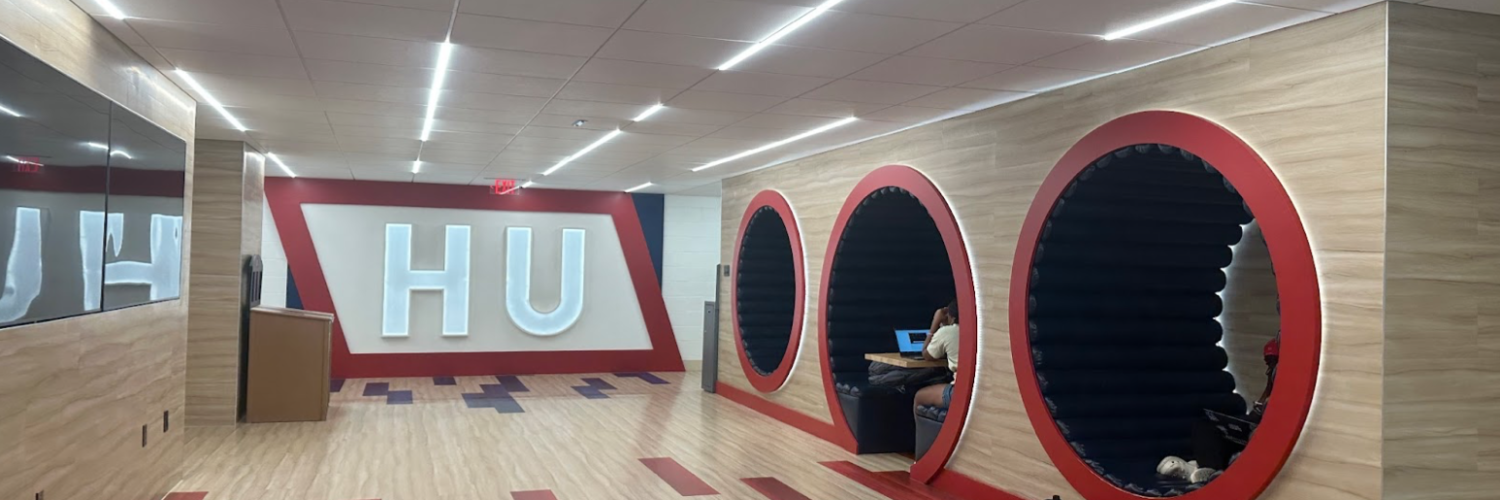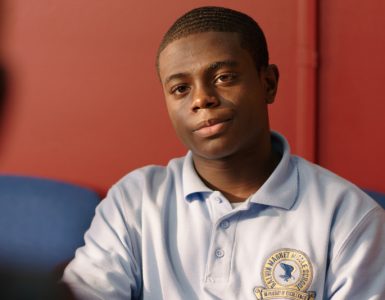As students return to campus for the Fall 2023 semester, some are initially learning that within the home of Howard University’s College of Arts and Sciences (COAS), the first floor of Alain Locke Hall has a brand new look after undergoing unannounced renovations over the summer.
What was once a run-down hall with single chairs and limited seating, has been transformed into a “futuristic” hall with newly placed wood-paneled flooring, built-in-the wall monitor screens, and cushioned seating lounge areas accompanied by worktables and outlets. Not to mention, a large wall panel featuring life-sized illuminated letters that read “H-U.” The basement, second, and third floor of Locke hall have yet to be renovated, including the classrooms on each of these floors.
Founded in 1867, COAS remains the oldest and largest department out of thirteen schools and colleges on the campus, hence its designation as the “flagship” college of the university. Locke Hall is the namesake of the American philosopher Alain Leroy Locke, known as the “Father of the Harlem Renaissance,” who served as professor and chair of the Department of Philosophy at Howard University.
Pictured above: The second floor of Alain Locke Hall, which remains unrenovated. (MyAhna Alston/101 Magazine)
Aubrey Tazewell, a senior political science major from Virginia Beach, Virginia, who visits Locke often as a COAS student, was appreciative of the lobby’s remodel. “I think that the renovations are really cool. I’m glad the flagship school is getting a revamp, that means a lot for COAS students since we spend so much time there… the renovations have made the hall much livelier than it was in previous years,” Tazewell said.
“When I walked in there I was definitely impressed. I didn’t even know they were doing renovations in the first place, ” admits Kalahari Deprez, a senior journalism major, theater arts minor from Miami, Florida. “So to walk in there and see that there were new seating areas, that was something I’ve always felt like Howard didn’t have enough of… and it does look kind of futuristic. It does look nice,” Deprez added.
When asked about the convenience of the new lounge areas, Deprez answered, “Sometimes I need that. I don’t want to just rush to this place, rush to that place. I just want to sit down for a minute and gather myself.”
In 2020, the institution announced a Central Campus Master Plan (CMP), and a kickoff investment of $785 million dollars to accelerate its planned series of real estate projects, aside from Locke Hall’s ongoing renovations.
Locke Hall’s revamp is the work of the institution’s Physical Facilities Management (PFM) office. The construction work began over the summer, and most of the current ongoing work in the hall is expected to be completed by the end of September, according to Timothy Millner, Executive Director of Physical Facilities Management at Howard University.
Millner detailed the future renovation plans for the building, including ongoing upgrades to the heating and cooling system which will continue for a few more months.
“There are also some utility spaces in the lower level that are being converted into spaces that are more usable. We expect to replace the roof this year as well. The lobby area is essentially finished,” he said.
As for the design choice and layout of the lobby, Millner says it “was a team effort resulting from input from various sources, including previous projects and interactions with the Howard community.”
Dr. Rubin Patterson – Dean of COAS – elaborates on the purpose behind the renovations saying, “Howard University’s comprehensive PFM and Real Estate Development plans encompass three distinct phases, each vital to enhancing the campus environment and the campus experience for students, faculty and staff.” He further explains that the first phase of renovations involved the modernization of campus residence halls, while the second phase includes the renewal of academic spaces.
Regarding reconstruction plans underway in Locke Hall, Dean Patterson tells 101 Magazine, “Other parts of the Locke Hall renovations are already underway–with HVAC, roofing, and space management projects soon to be completed. Major classroom renovations are not yet scheduled, but will be completed as part of the larger, university-wide, real estate development undertaking. The COAS Dean’s suite is also under renovation and will be completed next month.”
Regarding funding for the lobby renovations, Patterson clarifies the renovations were taken from the PFM capital expenditure budget and is not part of the University’s $785M infusion in its real estate development plan.
Current students and alumni take to the social media platform X, formerly known as Twitter, to express their reactions to the building’s improved lobby. (MyAhna Alston/101 Magazine)
Numerous students went online to voice their wishes to see renovations completed in their major-related buildings. While it is no secret that the university has several renovation projects underway – as part of a larger campus-wide renovation plan – the remodel of Locke Hall comes at a time when a number of students and staff await the completion and reopening of their respective departmental buildings.
Tatumn Williams, a senior health management major, believes upgrades to campus buildings positively affect student’s attitudes toward learning.
“I feel like renovations do help improve productivity and creativity because it encourages students to visit these facilities and use the new technology to their advantage. I feel like that is the reason UGL is so popular, it’s the newest library on campus,” Williams said. “Having renovated spaces also allows students to feel they’re getting their ‘money’s worth’ out of tuition. When things are rundown and old, it’s discouraging because [it’s] like, ‘what are we paying for?’”
Meanwhile, classes within the communications, nursing, and education programs have been relocated due to the reconstruction projects underway on campus. Prior to 2021, the University contracted the use of a temporary College of Nursing and Allied Health Sciences (CNAHS) building in Northeast D.C. as an operating facility for students enrolled in programs within the department.
While she completely supports the refurbished look of Locke Hall, Williams strongly feels that the university should dedicate more time to prioritizing the completion of the original CNAHS renovations, given inconveniences the building’s closure poses to CNAHS students.
“That’s also why it’s really sad the CNAHS building renovations aren’t a priority for the university. Not having our own building on campus causes a disconnect within our school, and [CNAHS students] really don’t have a strong community,” Williams said. “It’s also a safety issue because some classes at 801 [N Capitol Street NE] are until 8 p.m., meaning by the time we get back on campus, it’s dark out. I’ve heard several people complain about getting harassed or even chased after leaving 801 trying to get home.”
Having recently ran for Miss College of Nursing and Allied Health Sciences, Williams details facing campaigning difficulties due to her targeted student body being divided between campus and the temporary off-campus building located at 801 North Capitol Street NE.
“It was an interesting experience trying to campaign for CNAHS students on campus, because literally everyone is so spread out. CNAHS is made up of many majors…but the only way to make connections with those students was going straight to the CNAHS building, “ she elaborated. “Only one person was allowed to table in the CNAHS building at a time, while everyone else campaigning for other schools were able to table on the Yard and at their schools on campus.”
Likewise, enrolled students or faculty employed within The Cathy Hughes School of Communications (CHSOC) have been temporarily using the Metropolitan High School (MET) on Bryant St. NW to attend classes since 2021, due to unsafe operating conditions within the CB Powell Building.
The CB Powell Building was originally home to the CHSOC and is set to be transformed into a STEM center. Likewise, the institution is set to build a similar multidisciplinary building which would incorporate a combination of the CHSOC and the Chadwick Boseman College of Fine Arts (COFA). The framework: a Center for Arts and Communications behind Cramton Auditorium and the COFA.
Furthermore, the first project in the aforementioned series of real estate developments is the extensive restoration of the Myrtilla Miner Building. The restoration is expected to be finished by 2024, which is also when students and staff within the School of Education can expect to attend classes in the rehabilitated building. Additionally included in the reconstruction plans are student housing options, added on-campus recreational centers, a new hospital, and medical office building.
To read more details on Howard University’s ongoing construction projects throughout the campus, feel free to visit the institution’s Real Estate Development & Capital Asset Management webpage.










Recent Comments